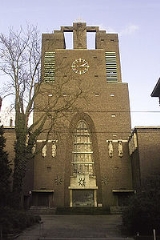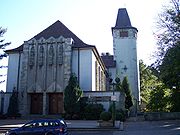
Josef Franke
Encyclopedia





Sacred
Holiness, or sanctity, is in general the state of being holy or sacred...
and secular buildings, in the Ruhrgebiet, particularly in Gelsenkirchen. He is noted for his work of the 1920s in the brick-expressionist
Expressionist architecture
Expressionist architecture was an architectural movement that developed in Europe during the first decades of the 20th century in parallel with the expressionist visual and performing arts....
style.
Life
After leaving school, Franke studied at the HöxterHöxter
Höxter is the seat of the Höxter district, and a town in eastern North Rhine-Westphalia on the left bank of the river Weser, 52 km north of Kassel in the centre of the Weser Uplands...
Baugewerkschule (English:building trade school) and then at the Technical university of Charlottenburg as a guest student. After completing his training he first was employed at the council structural engineering office in Cologne
Cologne
Cologne is Germany's fourth-largest city , and is the largest city both in the Germany Federal State of North Rhine-Westphalia and within the Rhine-Ruhr Metropolitan Area, one of the major European metropolitan areas with more than ten million inhabitants.Cologne is located on both sides of the...
, and later in the architect's office of Max and Carl Anton Meckel in Freiburg im Breisgau. In 1904 he set up on his own in Gelsenkirchen. Frankes second own house, completed in 1909, is located in Gelsenkirchen in the Robert-Koch-Straße. In recent years, Frankes work in Gelsenkirchen has been rediscovered and re-evaluated by exhibitions and publications. His daughter is the Interior design
Interior design
Interior design describes a group of various yet related projects that involve turning an interior space into an effective setting for the range of human activities are to take place there. An interior designer is someone who conducts such projects...
er and Artist
Artist
An artist is a person engaged in one or more of any of a broad spectrum of activities related to creating art, practicing the arts and/or demonstrating an art. The common usage in both everyday speech and academic discourse is a practitioner in the visual arts only...
Margarete Franke.
Architectural style
Frankes most popular buildings were designed in the Brick-expressionistExpressionist architecture
Expressionist architecture was an architectural movement that developed in Europe during the first decades of the 20th century in parallel with the expressionist visual and performing arts....
style, which was common in the 1920s Germany. They are characteristised by the use of reddish brown brick and its setting to patterns and plastic elements on Facade
Facade
A facade or façade is generally one exterior side of a building, usually, but not always, the front. The word comes from the French language, literally meaning "frontage" or "face"....
s, added to mostly rhythmic surface schemes. Playing with the angular, raw stone leads to a special charm, completed by carefully balanced total composition. Also the contemporary liking for triangle
Triangle
A triangle is one of the basic shapes of geometry: a polygon with three corners or vertices and three sides or edges which are line segments. A triangle with vertices A, B, and C is denoted ....
and parabola
Parabola
In mathematics, the parabola is a conic section, the intersection of a right circular conical surface and a plane parallel to a generating straight line of that surface...
forms reflects in his designs of this period.
Buildings (Selected)
- House for the painter Andreas Wilhelm Ballin, 1925, Gelsenkirchen-Bulmke
- Blumendelle housing scheme, 1926, Gelsenkirchen-Schalke
- Tram Depot for the Bochum-Gelsenkirchener Straßenbahnen AGBOGESTRAThe Bochum-Gelsenkirchener Straßenbahnen AG is a public transport operator in the Ruhr area, most notably in the cities of Bochum, Gelsenkirchen and Herne, and is integrated in the Rhine-Ruhr Stadtbahn network.-See also:* List of rapid transit systems...
, 1927, Gelsenkirchen-Mitte - "Ring-Eck" residential building with shops, 1928, Gelsenkirchen-Mitte
- Catholic parish church "Heilig-Kreuz", 1929, Gelsenkirchen-Ückendorf
- "Aloysianum" girls' high school, today "Ricarda Huch Gymnasium", 1930, Gelsenkirchen-Bulmke
Further reading
- Architektur-Kolloquium Bochum (Editor): Josef Franke. 163 Entwürfe für das 20. Jahrhundert. Klartext-Verlag, Essen 1999, ISBN 3-88474-776-2.

